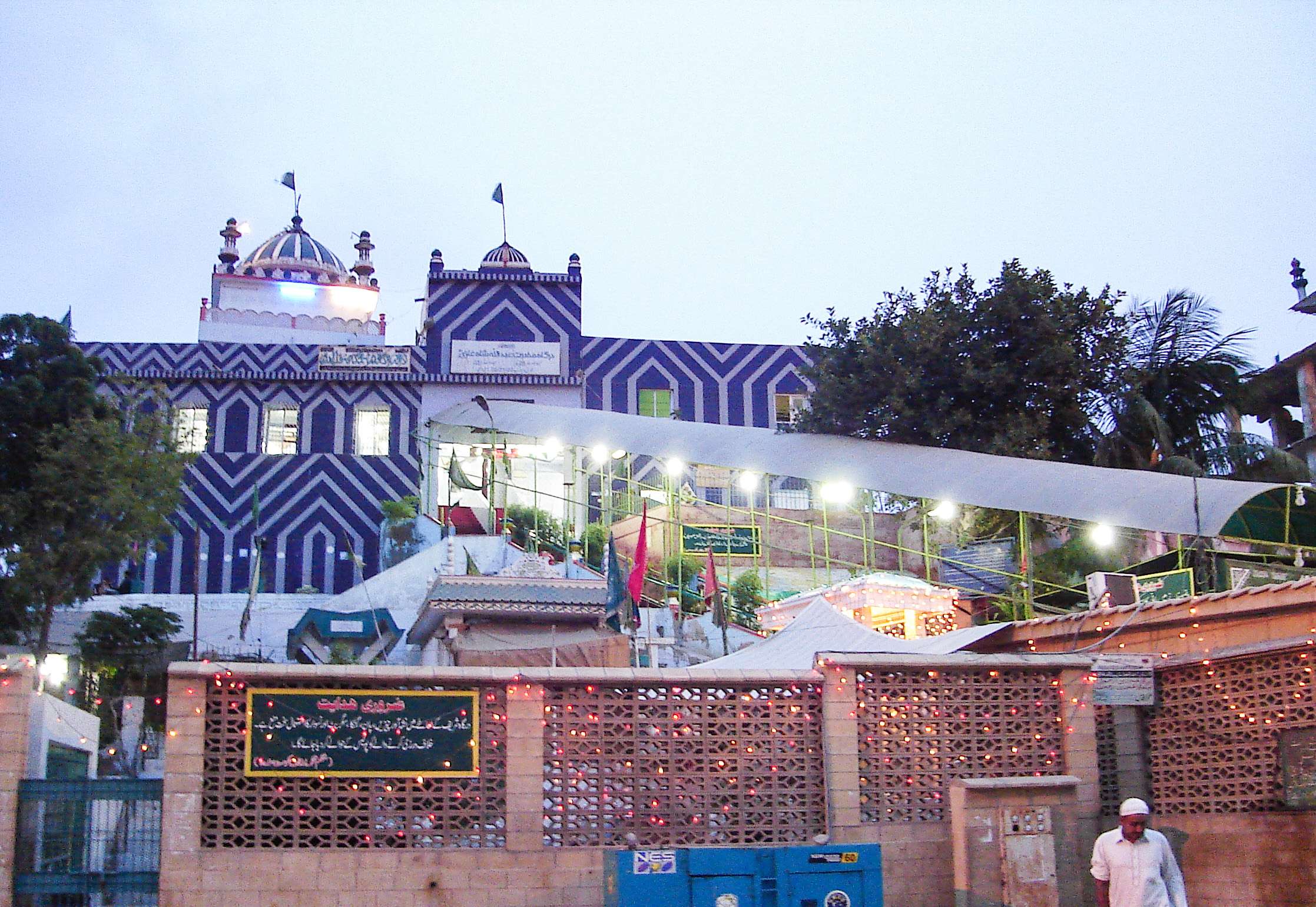Abdullah Shah Ghazi
Abdullah Shah Ghazi (Arabic: عبد الله شاه غازي) (c. 720) was an eighth-century Muslim mystic and Sufi whose shrine is located in Clifton in Karachi, in Sindh province of Pakistan.[1] His real name was Abdullah al-Ashtar. His father, Muhammad al-Nafs al-Zakiyya, was a descendant of Muhammad through his daughter Fatimah.
- See also Ghazi and Gazi (disambiguation)
Abdullah Shah Ghazi (Abdullah al-Ashtar) | |
|---|---|
عبداللہ شاہ غازی (عبدللہ الاشتر) | |
 The iconic shrine of Abdullah Shah Ghazi in Karachi, Pakistan, built by Murshid Nadir Ali Shah of Sehwan Sharif | |
| Personal | |
| Born | 720 CE |
| Religion | Islam |
| Parents |
|
| Ethnicity | Pakistani Arab |
| Known for | Sufi mysticism |
| Muslim leader | |
| Period in office | 8th century |
| Part of a series on |
| Islam |
|---|
 |
|
| Part of a series on Islam Sufism |
|---|
|
List of sufis |
|
|
Martyrdom

Sohail Lari suggests (in his book, A History of Sindh) that Shah Ghazi was an Arab merchant who had come to Sindh with the first wave of Arab invaders. However, another noted historian, M. Daudpota, suggests that Ghazi arrived in the area from Iraq as a commander, who along with Muhammed Bin Qasim, fought Sindh’s Hindu ruler, Raja Dahir, in the eighth century.[2] Abdullah Shah Ghazi was said to have been killed in a forest in the interior Sindh by his enemies. His devotees buried his body on top of a hill at the coastal area, where he had earlier arrived on an Arab ship. This area now lies in the vicinity of Clifton and Sea View in Karachi.[2]
Shrine

The tomb is built on a high platform, though the body is kept in a subterranean crypt. The shrine is made of a high, square chamber and a green-and-white striped dome, decorated with Sindhi tilework, flags and buntings. Devotees to the shrine caress the silver railing around the burial place and drape it with garlands of flowers. The shrine is highly regarded and respected by people of all ethnicities and religions.[3][4]
Until the early twentieth century, the shrine was a small hut on top of a sandy hill in Clifton. The shrine was built and expanded by Murshid Nadir Ali Shah, a sufi saint of Qalandariyya Sufi Order and the then custodian of the shrine.[5][6][7] The iconic building of the shrine, its stairs, mosque, Langar Khana, Qawwali Hall and pilgrim lodge were built under his supervision.[7] The shrine became a centre of attraction for people belonging to different sects, ethnicities and sections of society.[4] Free meals and the devotional poetry such as Qawwali became the essential features of the shrine[1] The shrine was always devotionally connected to Nadir Ali Shah's dervish lodge, called Pathan Kafi in Sehwan Sharif and for a long time the arrangements of the shrine and langar continued under his supervision.[6][8] In 1962, the Auqāf department took its administrative control. The twice a day free meal started by Nadir Ali Shah continued under the management of his followers.[1][7] In 2011, the shrine was handed over to a Pakistani construction giant, Bahria Town, who renovated the exterior of the shrine.[9] This received a mixed response from the residents of Karachi.[10]
The Abdullah Shah Ghazi shrine was attacked in 2010 by militants who detonated two suicide bombs at the shrine, killing 10 and injuring 50.[3]
See also
- List of mausoleums and shrines in Pakistan
- Muhammad al-Nafs al-Zakiyya, descendant of Imam Hasan ibn Ali
- Nadir Ali Shah
- Gazi Pir
References
- Asim Butt (11 August 2005). "Pakistan's mystical Islam thrives". BBC News. Archived from the original on 8 May 2009. Retrieved 12 February 2018.
- https://www.dawn.com/news/1145799
- Paracha, Nadeem (23 November 2014). "Abdullah Shah Ghazi: The saviour saint". Dawn (newspaper). Retrieved 12 February 2018.
- "Saint Ghazi and his shrine". DAWN.COM. 8 October 2010. Retrieved 20 July 2020.
- "غازی بابا کے مزارکی تعمیر قلندری بزرگوں نے کی تھی". ummat.net (in Urdu). Archived from the original on 26 July 2018.
- "1290 سال پرانا مزار عبداللہ شاہ غازیؒ". ایکسپریس اردو. 4 August 2019. Retrieved 26 February 2020.
- Brohi, Ali Ahmed (1984). Jam, Jamot aen Jamra. Karachi: Sindh Salamat Kitab Ghar. pp. 77–80.
- Shaw, Isobel (1999). Pakistan Handbook. Pakistan: Moon Publications. p. 59. ISBN 0918373565.
- "Takeover of shrines: Private company to run Abdullah Shah Ghazi - The Express Tribune". tribune.com.pk. Retrieved 13 February 2018.
- "City Faith – Abdullah Shah Ghazi shrine revisited". thekarachiwalla.com. Retrieved 2 October 2019.